Potrebujeme váš súhlas na využitie jednotlivých dát, aby sa vám okrem iného mohli ukazovať informácie týkajúce sa vašich záujmov. Súhlas udelíte kliknutím na tlačidlo „OK“.
ASTM D3339-12
Standard Test Method for Acid Number of Petroleum Products by Semi-Micro Color Indicator Titration
Automaticky preložený názov:
Štandardná skúšobná metóda pre Acid Počet ropných produktov Semi-Micro Color Ukazovateľ titrácie
NORMA vydaná dňa 15.4.2012
Informácie o norme:
Označenie normy: ASTM D3339-12
Poznámka: NEPLATNÁ
Dátum vydania normy: 15.4.2012
Kód tovaru: NS-23343
Počet strán: 8
Približná hmotnosť: 24 g (0.05 libier)
Krajina: Americká technická norma
Kategória: Technické normy ASTM
Kategórie - podobné normy:
Anotácia textu normy ASTM D3339-12 :
Keywords:
acid number, petroleum products, semi-micro color indicator titration, ICS Number Code 75.080 (Petroleum products in general)
Doplňujúce informácie
| Significance and Use | ||||||||
|
This test method measures the acid number of oils obtained from laboratory oxidation tests using smaller amounts of sample than Test Methods D974 or D664. It has specific application in Test Method D943 in which small aliquots of oil are periodically removed for testing by Test Method D3339. This test method, therefore, provides a means of monitoring the relative oxidation of oils, by measuring changes in acid number, at different time intervals and under the various oxidizing test conditions.
|
||||||||
| 1. Scope | ||||||||
|
1.1 This test method covers the determination of acidic constituents in new or used petroleum products and lubricants soluble or nearly soluble in mixtures of toluene, and isopropyl alcohol. The test method is especially intended for cases in which the amount of sample available to be analyzed is too small to allow accurate analysis by Test Methods D974 or D664. It is applicable for the determination of acids having dissociation constants in water larger than 10−9. Extremely weak acids having dissociation constants smaller than 10−9 do not interfere. Salts titrate if their hydrolysis constants are larger than 10−9. 1.2 This test method can be used to indicate relative changes in acid number that occur in an oil during use under oxidizing conditions. Although the titration is made under definite equilibrium conditions, the method does not measure an absolute acidic property that can be used to predict performance of an oil under service conditions. No general relationship between bearing corrosion and acid number is known. 1.3 Since this test method requires substantially less sample than Test Methods D974 or D664, it provides an advantageous means of monitoring an oxidation test by changes in acid number by (1) minimizing test sample depletion for acid number analyses and thus minimizing the disturbance of the test or (2) allowing additional acid number analyses to be made while maintaining the same test sample depletion and thus providing additional data. Note 1—Some oils, such as many cutting oils, rust-proofing oils, and similar compounded oils, or excessively dark-colored oils, may be more difficult to analyze by this test method due to obscurity of the color-indicator end point. These oils can be analyzed by Test Method D664 provided sufficient sample is available. However, this situation is much less likely using Test Method D3339 than using Test Method D974 due to the use of a more highly dilute sample during the titration and due to the greater stability of the end point color change. The acid numbers obtained by Test Method D3339 may or may not be numerically the same as those obtained by Test Method D664 but they should be of the same order of magnitude. Note 2—The results obtained using this method have been found to be numerically the same as those obtained using Test Method D974, within the precision of the two methods, for new or oxidized lubricants of the type primarily intended for hydraulic or steam turbine type service. The oxidized lubricants were obtained using the Test Method D943 oxidation test. This correlation is shown by the correlation coefficient r = 0.989 with slope s = + 1.017 and intercept y = + 0.029, calculated using the acid numbers obtained using both titration methods for the samples used for the precision statement (12.2). 1.4 The values stated in SI units are to be regarded as standard. No other units of measurement are included in this standard. 1.5 This standard does not purport to address all of the safety concerns, if any, associated with its use. It is the responsibility of the user of this standard to establish appropriate safety and health practices and determine the applicability of regulatory limitations prior to use. For specific warning statements, see Sections 7 and 9, A1.1.4, A2.3.1, and A2.10.1. |
||||||||
| 2. Referenced Documents | ||||||||
|
Podobné normy:
Historická
1.6.2013
Historická
1.6.2014
Historická
1.4.2012
Historická
1.4.2012
Historická
1.1.2011
Historická
1.10.2013


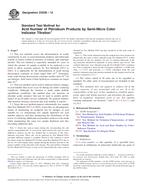
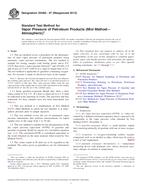 ASTM D5482-07(2013)..
ASTM D5482-07(2013)..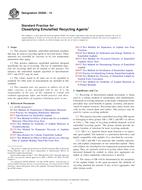 ASTM D5505-14
ASTM D5505-14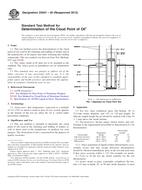 ASTM D5551-95(2012)..
ASTM D5551-95(2012)..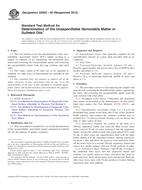 ASTM D5553-95(2012)..
ASTM D5553-95(2012)..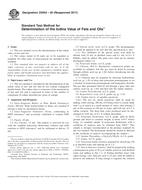 ASTM D5554-95(2011)..
ASTM D5554-95(2011)..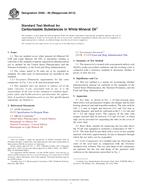 ASTM D565-99(2013)..
ASTM D565-99(2013)..
 Cookies
Cookies
